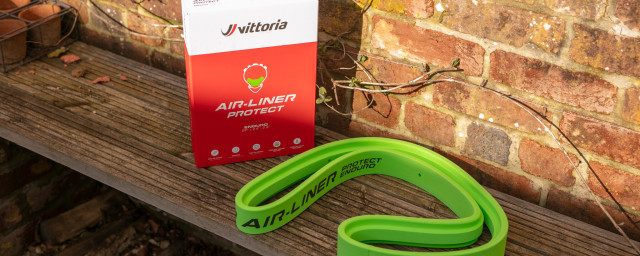Is HiRide's full-suspension system the future of gravel bikes?

While suspension and drop-bar bikes haven't traditionally gone hand in hand, HiRide aims to change that with a smart 'eSAS' full-suspension system specifically for road and gravel use that claims to improve comfort without losing efficiency. We rode it on the brutal cobbles of the legendary Arenberg to test it out.
- Which disc brake pads are best for mountain bikes? Sintered or organic?
- Your complete guide to the Fox Shox fork range
- The best gravel and adventure bikes you can buy for under £1,000
The system might be familiar to those that recall the rear-suspension only Pinarello Dogma K8-S road bike launched back in 2017, but HiRide's latest 'eSAS' system now incorporates a front suspension unit as well as rear on a frame of their own making. It's designed as a full proof of concept of their 'smart' full suspension system that's made specifically for gravel and road bikes, pitched as offering additional comfort and safety without a significant loss of pedalling efficiency.
So how does it work?
Although rather uncommon in most gravel and road bikes, the bouncy bits of the suspension HiRide uses is nothing particularly groundbreaking. HiRide's party trick is the way the system automatically locks and unlocks the suspension depending on what you're riding over, meaning that you get the comfort of full suspension when you need it and the efficiency of a rigid bike when you don't, all without the rider having to do anything.
The bike offers 11mm of rear wheel travel from a rubber elastomer spring and 25mm of front wheel travel, via a coil spring in a Headshok style arrangement. Both can be adjusted for rider weight by switching out springs respectively. Both have proper hydraulic damping that can be locked out using wired servo actuators that can switch the shocks from open to closed within 0.1s.
Just how and why that's done requires some basic suspension theory to explain and even more interesting trickery to achieve.
How does it know where the bumps are coming from?
Within any suspended vehicle there are two components to the system; the sprung mass and the unsprung mass. The former is what you want to keep as isolated as possible from bumps; in the case of a bicycle, it's the rider and the frame. The unsprung mass is anything that can't be isolated by the suspension, so wheels and tyres plus some parts of the suspension design such as fork legs.
In a normal 'dumb' suspension system, the shocks have no way of differentiating between whether a bump is coming from the sprung side of the system, such as a rider bouncing up and down while pedalling or weight shifting, or from the unsprung side - a bump. The suspension will compress regardless of whether it's a road bump or rider bouncing away on top, meaning a loss of energy and efficiency if the suspension is left open when it doesn't need to be.
While there are existing adaptive suspension systems out there - Fox's adaptive Live Valve mountain bike suspension is one such example - they tend to use quite complex and hence very pricey ways to detect whether the suspension input is coming from the ground or the rider.
That usually means having accelerometers mounted to the unsprung bits - fork lower and rear swingarm - as well as the sprung part - the frame - with a brain which then compares the inputs and decides where bumps are coming from. It can then actuate servos to control the damping from locked to open, often fast enough to respond to the bump it's hitting in real time, as is the case for Live Valve, which takes a claimed 3 milliseconds (0.003s) to react and switch the shock to open.
It's all in the mind...
The beauty of HiRide's system is that instead of using multiple sensor units and then figuring out what's going on by comparing inputs, it uses some extremely clever maths to analyse the frequency of all the bumps being input into a single frame mounted sensor.
Using clever algorithms, it then decides from these signatures whether it's input from the rider or bumps from the road that are causing them, before adjusting the shocks accordingly. It resamples every millisecond, so if the situation changes, it'll then actuate the shocks again to suit the conditions at that point.
It's a system that's been used by a number of motorbike brands such as Ducati, which is where HiRide's parent company has used it before for adapting the technology to bicycles.
While the two shock units are still physically wired to the control and sensor units, it cuts down on a whole load of extra wiring, complexity and reduces the need for as much frame integrating as the sensor can be placed anywhere inside a frame tube - the seat tube in this case - with the control unit and battery in the downtube.
The downside is that the system can't adapt quite as quickly as the bump vibrations need to hit the frame before it can respond. This would, for example, cause issues if you went from a perfectly smooth surface to a much rougher surface in a very small period of time as the shocks would be locked until after the bike had hit the bump, transmitting a big old shock to the rider - think riding from smooth tarmac into a super rough gravel (or cobbled) section at speed...
To get around this, the shocks use a blow-off valve that will open regardless if there's a big enough impact, giving you a little time until the system can open the shock's valving properly 0.1s later.
Through integration with a Garmin GPS acting as a display and control unit, it's possible to manually lock and unlock the suspension of the bike on the fly using the touchscreen. That's pretty neat, but the automatic mode is where the system comes into its own, as you simply ride and let the system get on with deciding when you need a bouncy bike and when you're best with a rigid one.
In auto, it also has a trio of sub-modes, with a 'sport' mode that will keep the bike locked out unless it gets fairly rough to maintain efficiency, a 'tourism' mode where it's much more eager to open the suspension to keep you comfy plus a 'custom' setting that allows you to put it where you want.
How does it ride?
There are few more testing places for a road bike than the cobbled sections of road that make up part of the Paris-Roubaix road race, so it was rather appropriate that this was where HiRide invited us to test the system.
The surface is mostly flat in gradient but brutally rough and unrelenting. Even by mountain bike standards, it's bloody lumpy and on a fully rigid bike, it's an extremely punishing experience. I took along a Lauf True Grit gravel bike - one of our favourite gravel machines - as it has their bump smoothing leaf sprung fork on the front.
There's no doubt that on the cobbles, the suspension system makes a huge difference in terms of control, despite the test bike running pretty skinny 32mm rubber. Having both wheels suspended and damping meant the bike was much easier to keep on a line through the cobbles and it also meant much less of a beating through the bottom as well.
That said, the Lauf was running fatter 40mm tyres and the admittedly undamped 30mm or so of travel also made a big difference to comfort and control, though it definitely took more effort to keep it tracking true and there was much more of a kick at the rear.
It's also noticeable that as the suspension works to keep the tyre in contact with the ground more of the time, there's much more traction as you're pedalling, with less of the bounce and slip you'd usually expect on rough ground.
Of course, Arenberg's cobbles aren't particularly representative of most gravel riding and even less so of road. They also didn't do much to highlight the clever bit of the system, namely it being able to switch modes on the fly, though leaving the system in an 'auto' setting and hopping into the cobbles from the smooth side path showed that the blow-off valve works to prevent things getting too harsh before the system can open up.
It was much more interesting to switch the system into an auto setting and ride on the path and observe just how bumpy it needed to be for it to move out of the lockout mode - sure enough it worked just as advertised, with the 'sport' setting staying locked out much longer than the more comfort orientated 'tourism' mode. Unless I was looking at the display or listening out for the whirr of the servos kicking in, it was all pretty seamless.
So it is worth it?
Well, the hard thing about answering that is that we don't know how much the system is likely to cost on top of any bike it's fitted too. For example, the Pinarello Dogma K8-S with the original rear-only system was said to cost around €10,000, so it's unlikely to be a budget option at any point.
That said, HiRide isn't really interested in selling bikes as their real technology is in the electronic trickery that could be adapted to pretty much any kind of platform - it was telling that we saw plenty of people from a rather large bike brand (go on, guess) sniffing around the HiRide tent as we tested.
That said, the guts of the system are claimed to add around 600g to a bike, so there's a fair weight penalty to be had - as in pretty much any full-suspension system.
It's certainly a very interesting system from a technological standpoint and does seem to work as advertised from my relatively short experience, but whether the benefits it could offer in terms of comfort and efficiency would outweigh the cost and complexity relative to simpler solutions is a much harder thing to answer. For many, running a bike with a fatter tyre would probably be a simpler solution - though that might be missing the point of progress somewhat. Is it the future of gravel and road bikes? Well, I'm pretty sure it's got a future, in one form or another.

















